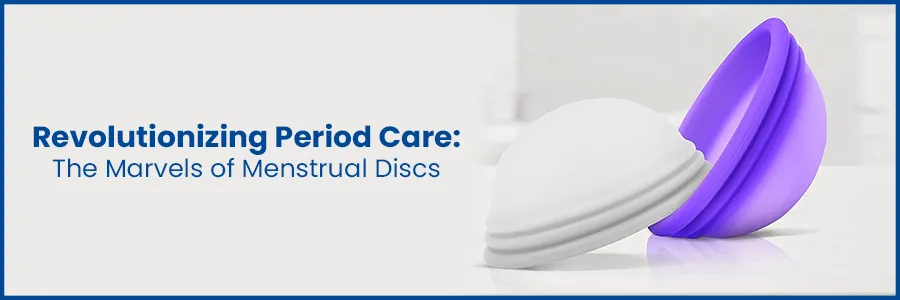
Revolutionizing Period Care: The Marvels of Menstrual Discs
As women, we've seen a surge of innovation in feminine hygiene products over the years. From pads to tampons, an array of choices is available to suit every preference. Enter menstrual discs—a revolutionary alternative gaining traction for its unique design and numerous benefits. In this blog, we'll delve into the world of menstrual discs, exploring what they are, how they work, and why they might be the game-changer you've been waiting for.
What Are Menstrual Discs?
Menstrual discs are flexible, saucer-shaped devices designed to collect menstrual fluid rather than absorb it. Unlike traditional tampons and pads, which absorb the liquid, these discs are inserted into the vaginal canal, where they sit beneath the cervix, collecting the menstrual flow more discreetly and comfortably.
The Mechanics Behind Menstrual Discs
Imagine a versatile silicone or rubber disc that moulds to your body's shape, creating a secure seal to prevent leaks. These discs are designed to hold more fluid than tampons and pads, offering longer-lasting protection—some wear time can extend to as long as 12 hours, contingent upon your menstrual flow.
Secure your health with a second opinion. Make informed decisions and book your appointment today!
Get A Second OpinionBenefits of Menstrual Discs
- Comfortable: Menstrual discs are known for their comfort. Once properly inserted, you usually won't feel them. Unlike tampons, they don't interfere with the vaginal canal's natural moisture.
- Leak-Proof: The unique design and placement of the disc make leaks less likely, even during activities like swimming, exercising, or sleeping.
- Longer Wear Time: With their higher capacity, menstrual discs can typically be worn for a longer duration compared to tampons or pads, which need more frequent changes.
- Eco-Friendly: Most menstrual discs are reusable, helping reduce the environmental impact of disposable products.
- Less Odor: Because the menstrual fluid isn't exposed to the air like it is with pads, there's generally less odour associated with using menstrual discs.
- Discreet: Once properly inserted, the disc sits internally and is virtually undetectable from the outside, providing a discreet option for managing your period.
Using Menstrual Discs: Tips and Tricks
- Practice Makes Perfect: Inserting and removing a menstrual disc might require a learning curve, so be patient as you get used to the process.
- Find Your Fold: Menstrual discs often require folding before insertion. Experiment with different folding methods to find the one that works best for you.
- Relax: Relax your pelvic muscles when inserting and removing the disc. This can make the process smoother and more comfortable.
- Hygiene Matters: As with any menstrual product, proper hygiene is crucial. Wash your hands before insertion and follow the manufacturer's guidelines for cleaning the disc.
Introducing Our Gynecologists:
At Medicover Hospitals, you can consult with experienced gynecologists who specialize in addressing menstrual problems and women's health concerns. Gynecologists play a crucial role in diagnosing and treating various menstrual issues to ensure women's well-being.
Conclusion:
Menstrual discs have swiftly made their mark in the world of feminine hygiene, offering a fresh perspective on period management. With their comfort, leak-proof design, and longer wear time, they provide an alternative worth considering for anyone looking to enhance their menstrual experience. While there might be a slight learning curve, the benefits are well worth the effort. As always, it's essential to choose the product that aligns with your body and lifestyle, allowing you to embrace your menstrual cycle with confidence and comfort.
Ready to take control of your health journey? Book your appointment now and start your path towards wellness today!
Book an AppointmentFrequently Asked Questions
Menstrual discs represent innovative feminine hygiene solutions crafted to gather menstrual fluid as opposed to absorbing it They are flexible, saucer-shaped devices that are inserted into the vaginal canal to capture menstrual flow.
Menstrual discs are inserted beneath the cervix, where they create a seal to prevent leaks. They collect menstrual fluid, and unlike tampons or pads, they don't interfere with the vagina's natural moisture.
Many menstrual discs are reusable. They can be washed and reused for several menstrual cycles, making them an eco-friendly alternative to disposable tampons and pads.
The wear time varies, but most menstrual discs can be worn for up to 12 hours before needing to be emptied. However, this may depend on your flow and the specific brand of disc.
Insertion involves folding the disc and sliding it into the vaginal canal, similar to inserting a tampon. Removal requires gently hooking your finger under the rim of the disc and carefully pulling it out.
Yes, menstrual discs are designed to be leak-proof, making them suitable for activities like swimming, exercising, and other physical activities.
Many users find menstrual discs comfortable once they are properly inserted. They mould to your body's shape and don't cause the same dryness or discomfort associated with tampons.
If inserted correctly, menstrual discs usually sit high in the vaginal canal, making them unlikely to interfere with intercourse.
However, it's recommended to remove the disc before engaging in sexual activity.
When used correctly, menstrual discs are generally safe. However, improper insertion or removal can lead to discomfort, and there's a small risk of infection if hygiene practices are not followed.
Yes, menstrual discs have a higher capacity than many tampons, making them suitable for individuals with heavy flows. However, you might need to empty and reinsert the disc more frequently.

Categories
- Cardiology 84
- Dermatology 45
- Endocrinology 33
- ENT 16
- Fertility 190
- Gastroenterology 78
- General-Medicine 81
- General 6
- Gynecology 80
- Hematology 19
- Infectious-Diseases 33
- Neurology 52
- Oncology 34
- Ophthalmology 23
- Orthopedics 69
- Pediatrics 31
- Procedure 23
- Public-Health 144
- Pulmonology 59
- Radiology 8
- Urology 68
- Wellness 161
- Woman-and-child 77